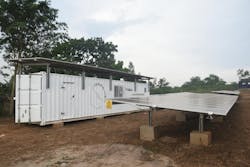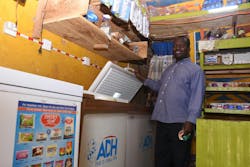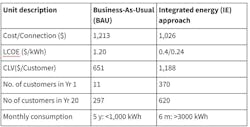In 2021, a coalition of centralized and decentralized energy companies, nonprofit organizations and a host of other partners commissioned a minigrid pilot project in Kiwumu, Uganda.
The coalition calls itself Utilities 2.0 and named its first pilot program “Twaake,” which means “let’s light” in Luganda, the language of the Ugandan people.
As a result of having access to reliable, clean energy from the minigrid, life in the village six miles north of the equator has been forever changed.
This week, that project received the prestigious Reuters Global Energy Transition 2024 Award for Socially Responsible Project. The award recognizes projects that prioritize social responsibility and driving change in the local community in which it operates.
“This award is a testament to the power of partnership. The project’s success is the result of the unwavering dedication and innovative spirit of our partners,” said Kristina Skierka, CEO of Power for All, in a LinkedIn post.
Integrated energy: A better approach to electrification?
Uganda is located along the northern shores of Lake Victoria in central Africa and just 45% of its population had access to electricity as of 2021.
Such was the case for many residents and businesses in Kiwumu, where the village essentially shut down at dusk.
Led by Umeme, Uganda’s largest power utility, and coordinated by Power for All, a nonprofit organization that promotes renewable, decentralized electrification, the Utilities 2.0 coalition sought to reduce the costs of electrifying villages not connected to the central power grid. The coalition selected Kiwumu for the pilot project.
Funded by a grant from the Rockefeller Foundation, the minigrid utilized an integrated energy design that leveraged both centralized and decentralized technology to deliver clean energy more quickly and at a lower cost than would be possible with expanding traditional transmission and distribution infrastructure.
Essentially, an integrated energy system creates an intelligent and interactive network made up of home solar systems, minigrids, smart grid systems and the main power grid.
Power for All expected that the design used for Twaake would cut connection costs by half.
When the pilot was commissioned in 2021, Selestino Bubungi, managing director and CEO of Umeme, said, “Uganda is now facing a challenge of access to clean energy with about half of the population having access, of which 25% are connected to the grid and 26% using offgrid solutions like solar. Twaake is coming in to bridge the gap of delivering clean energy to the households.”
The transformational power of electricity
The Kiwumu minigrid included 40 kW of solar and a 140-kWh battery to power more than 360 homes and 60 local businesses. It was expected to power its primary load, a maize milling and drying facility key to the community’s agrarian economy, 24 hours a day.
However, the minigrid’s electricity proved so popular with residents and other businesses that demand increased by nearly 200%, according to Brian Kawuma, the Ugandan-based campaign director at Power for All.
To meet household demand for electricity at night, the maize operation shifted to running only during the day when residential demand was low.
The local economy got a significant boost thanks to the minigrid, with new businesses like bars, beauty salons, an entertainment center and even a job training center popping up.
During the pilot, these new businesses saw revenues increase by 68%, according to Kawuma, and the community has become a regional destination for entertainment and commerce.
A successful pilot
“To a large extent, the Utilities 2.0 integrated energy pilot delivered on its goals,” Kawuma told Microgrid Knowledge in an email. “It showed the enormous potential of an integrated energy approach.”
Kawuma pointed to the pace of electricity access, which he said was accelerated by five years compared to a business as usual (BAU) approach. He also said customer education around how people would receive and pay for electricity accelerated demand by 3,000%, and in an eighth of the time taken by the BAU approach.
The integrated energy approach was also cheaper than the BAU approach – at least at the pilot level, according to Kawuma.
Lessons learned
There were many factors that contributed to the success of the Twaake minigrid pilot, according to Kawuma, not the least of which was the project framework agreements between the various partners, including Umeme, Power for All, Equatorial Power, EnerGrow and East Africa Power.
“The project took a focus on humans, the public good of energy access vis-a-vis a profit-only motive,” Kawuma said. “There was deliberate community engagement of the locals in addition to customer education on efficient electricity use. Also, the minigrid had a customer support team that was readily accessible by its customers.”
Kawuma also pointed to the funding from the Rockefeller Foundation, support from the Ugandan Ministry of Energy and Mineral Developments, as well as assistance from research partners RMI, the University of Massachusetts and Makerere University as being key to the project’s success.
The end game
Interconnection was always the end game for this minigrid. Customers acquired during the life of the project are all now connected to the grid, and the minigrid has since been decommissioned, Kawuma reported.
To further prove the scalability of the integrated energy approach used in Kiwumu, the Utilities 2.0 coalition aims to replicate the pilot at six more sites across Uganda, where it is expected to provide similar benefits and see similar success.
Track News on Microgrids Globally: Subscribe to our Free MGK Newsletter











